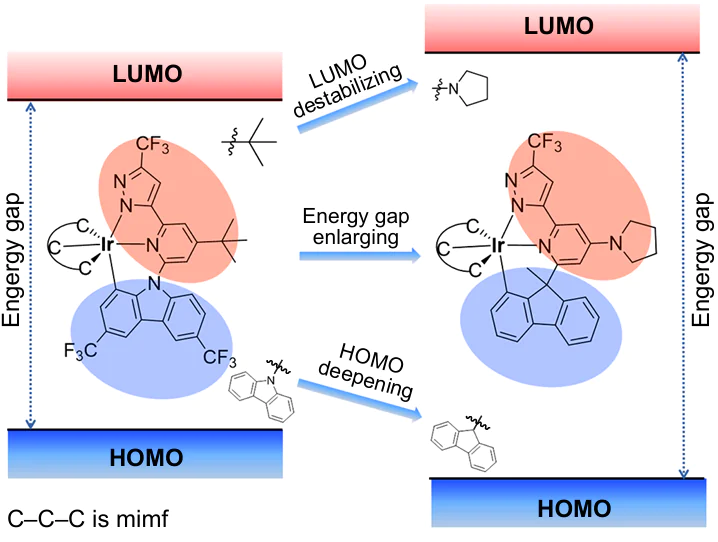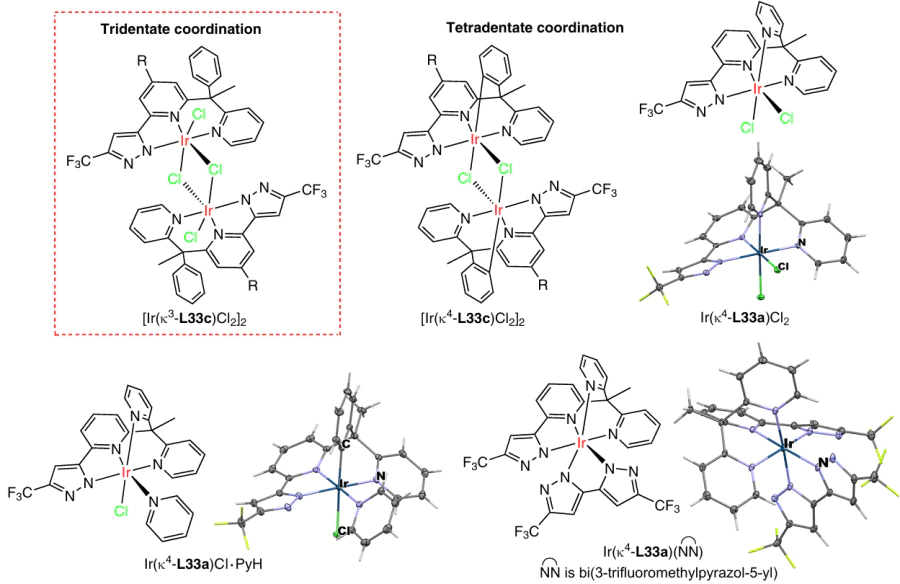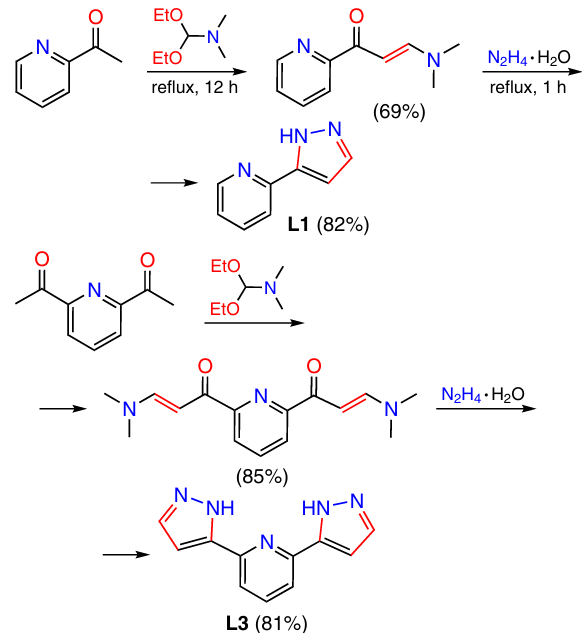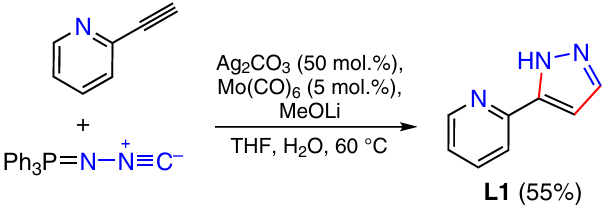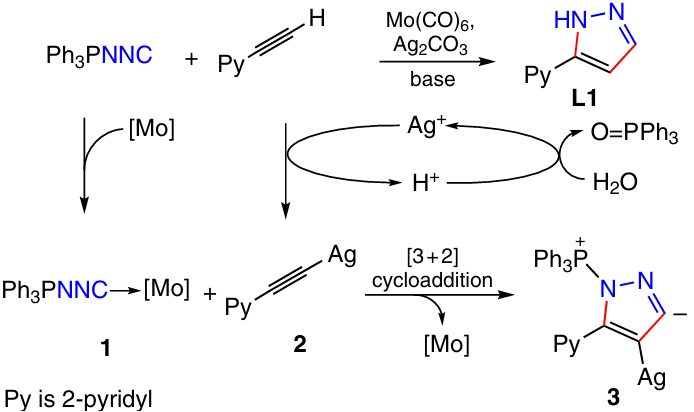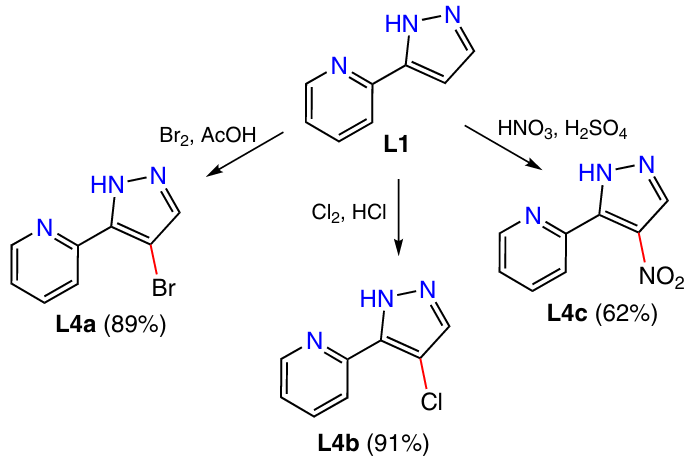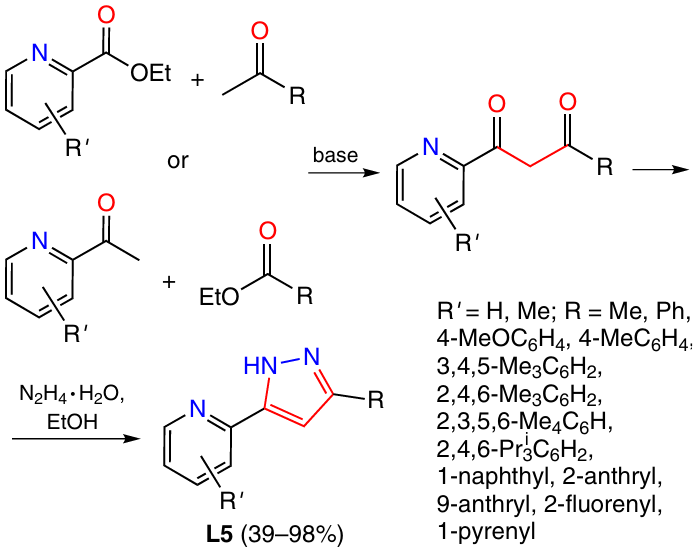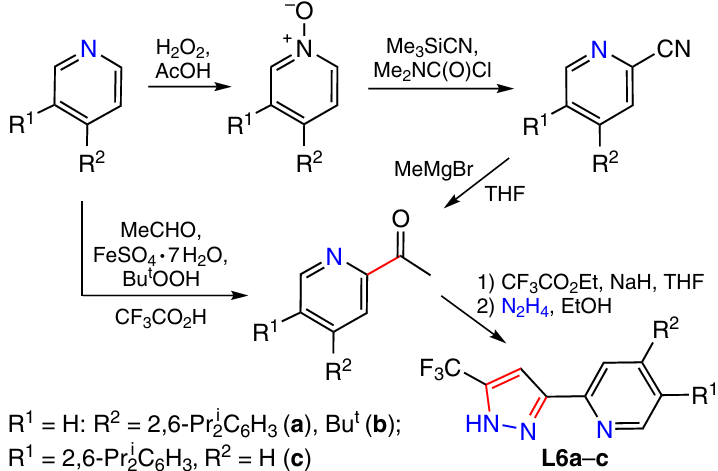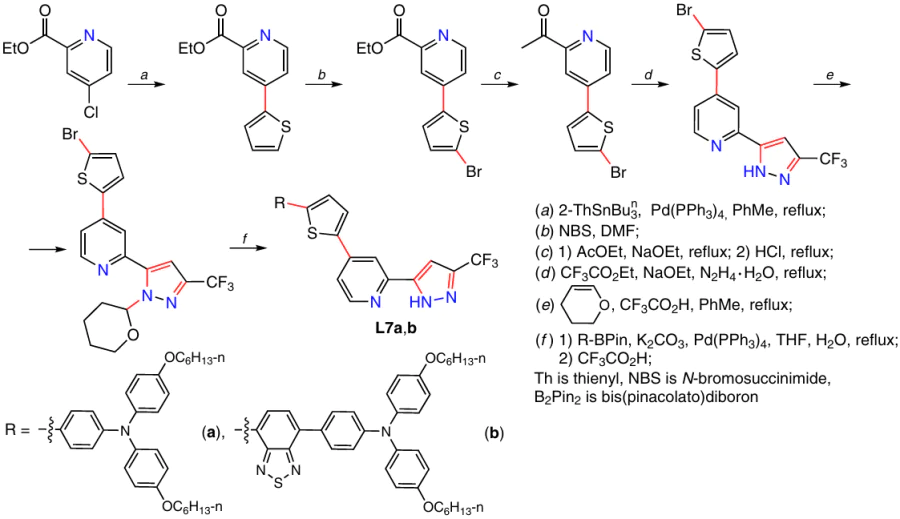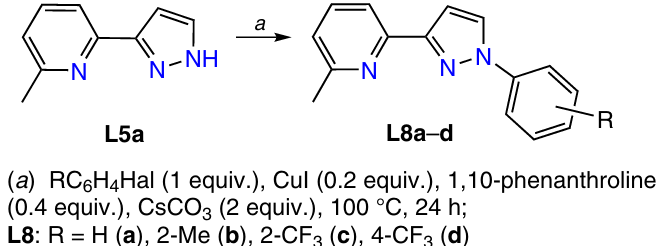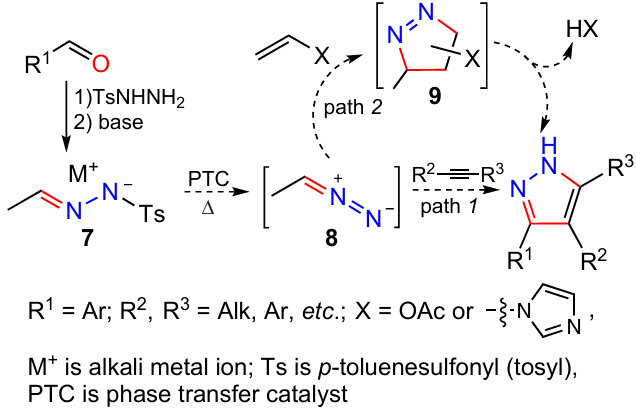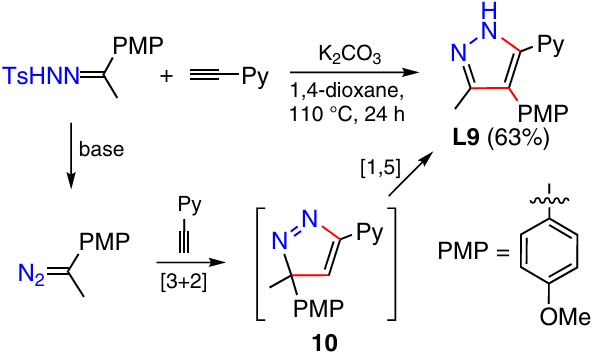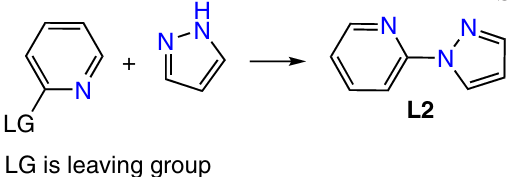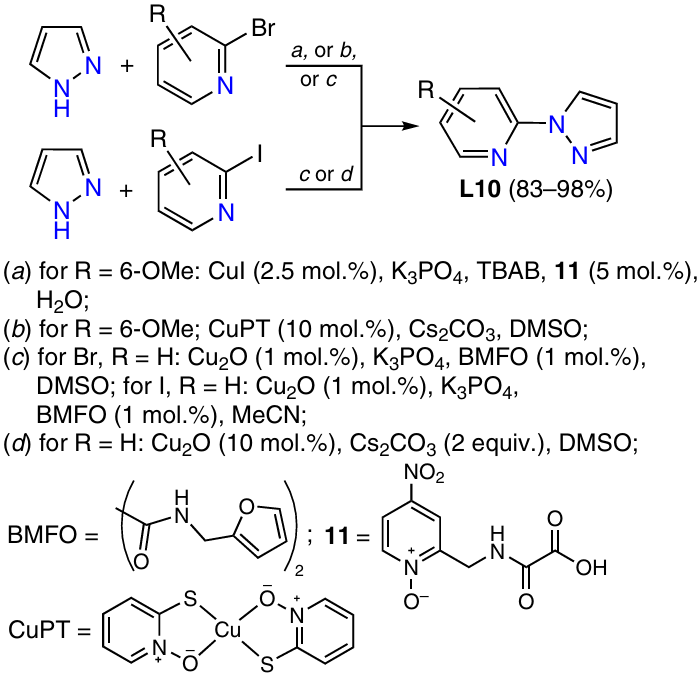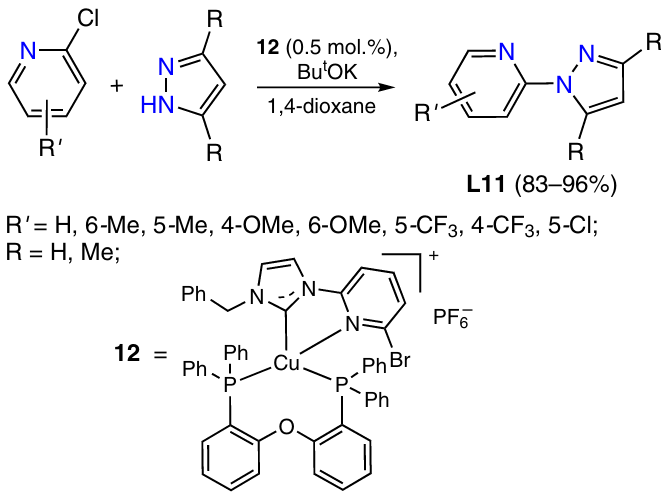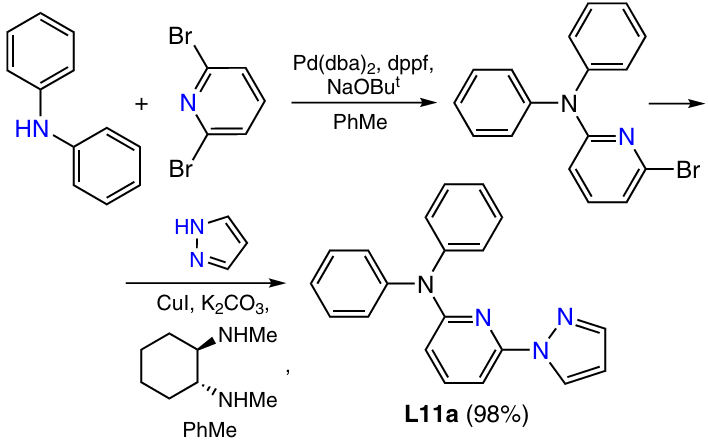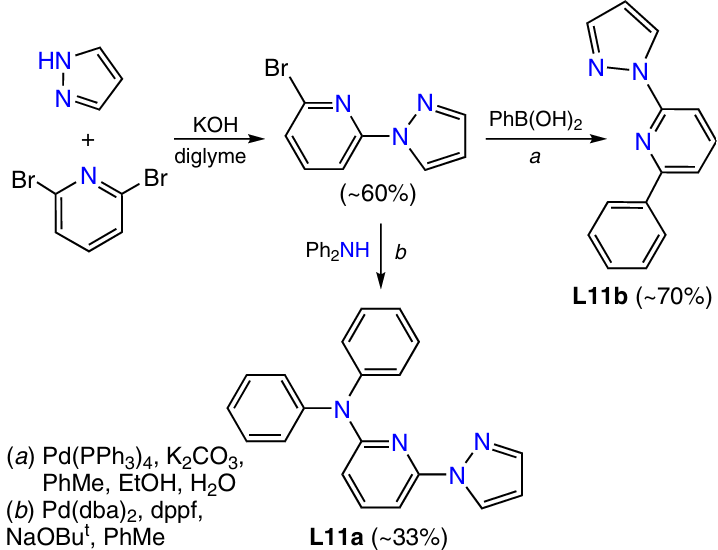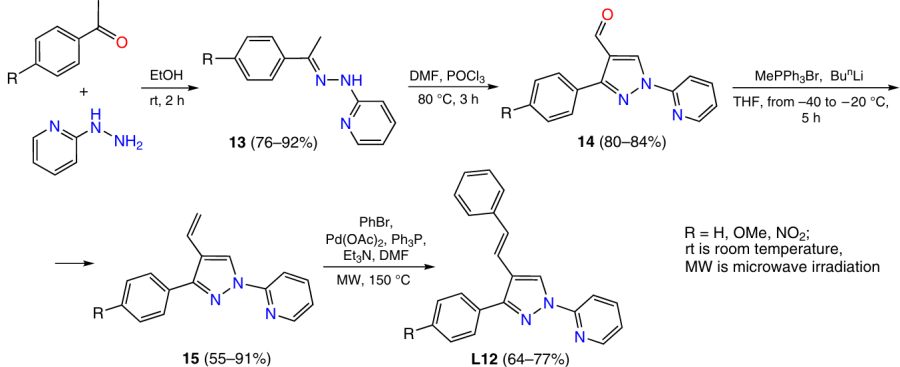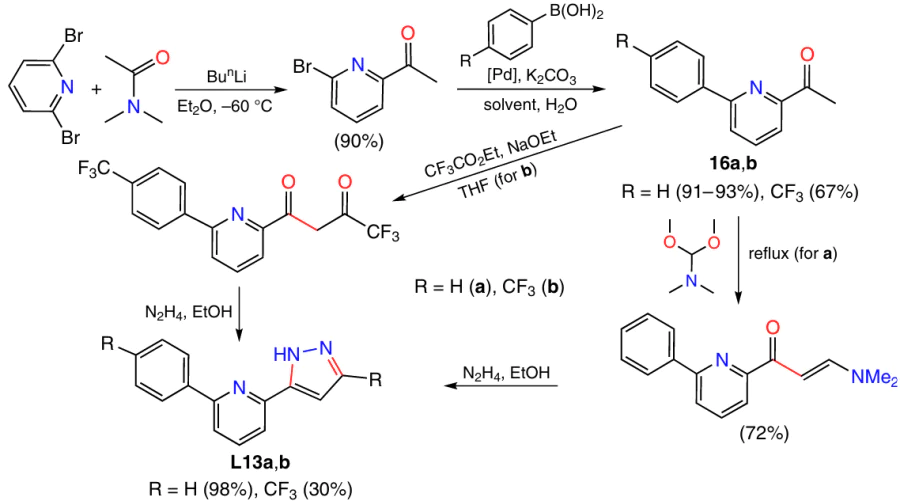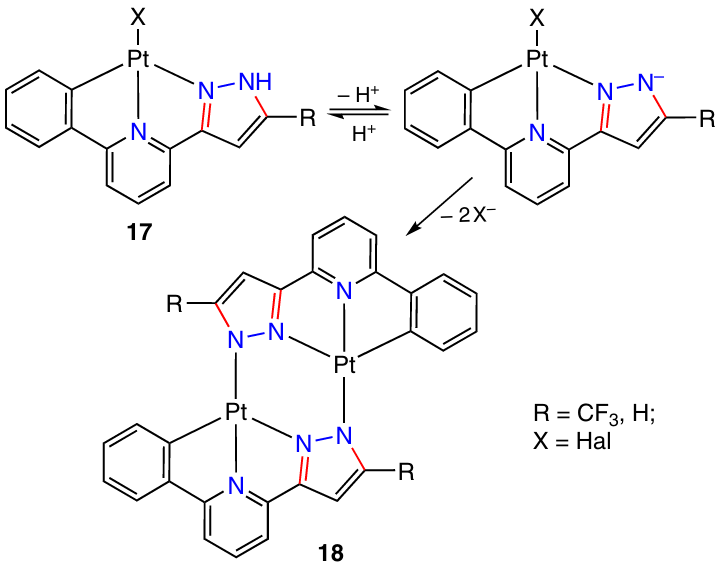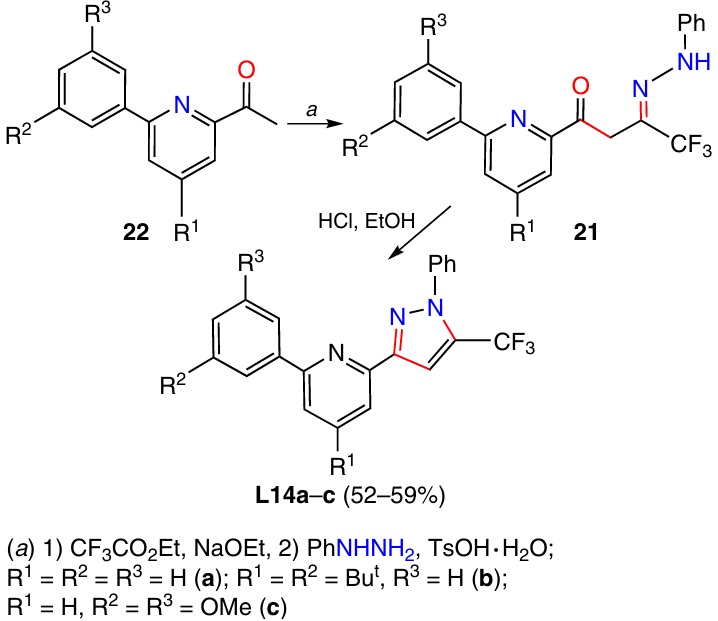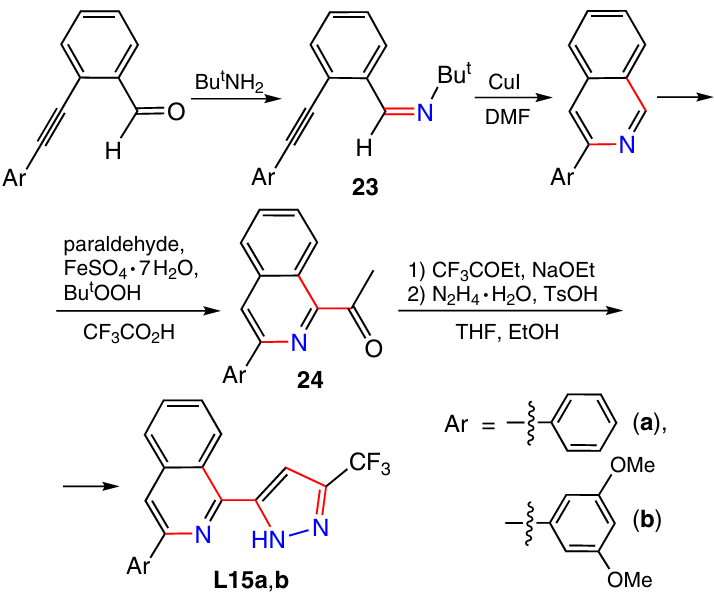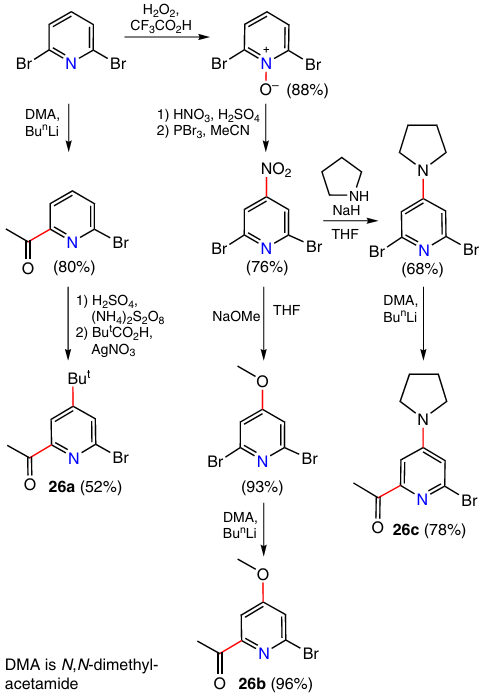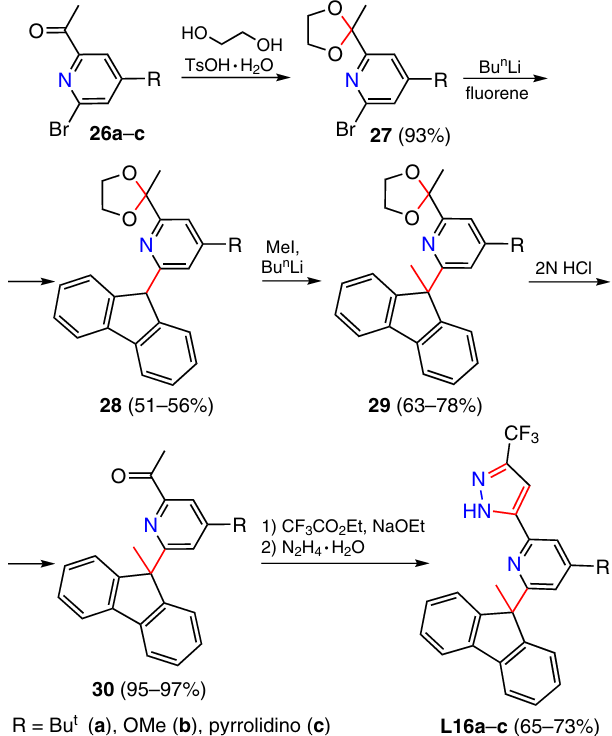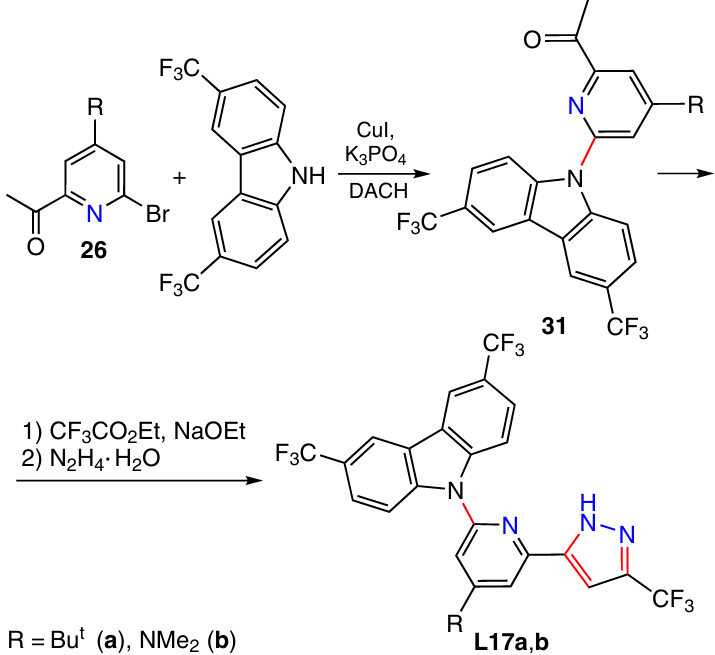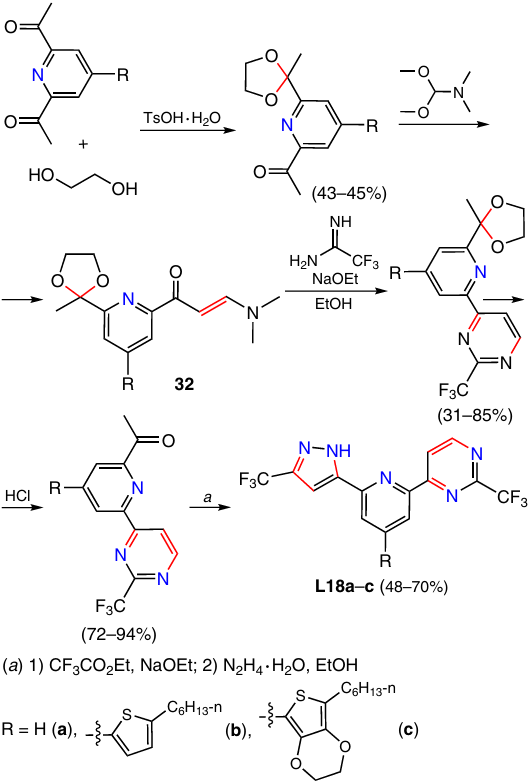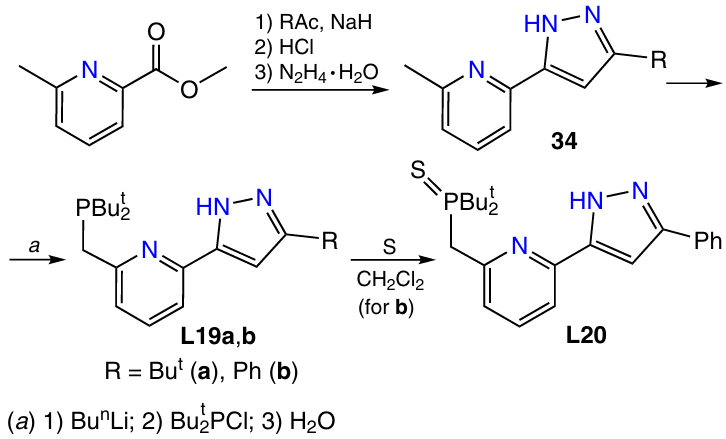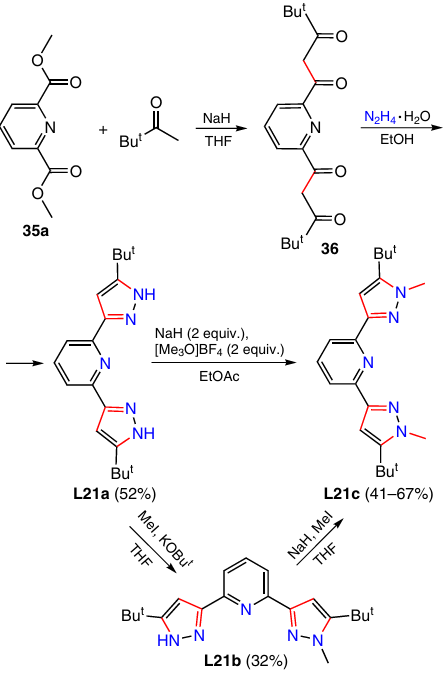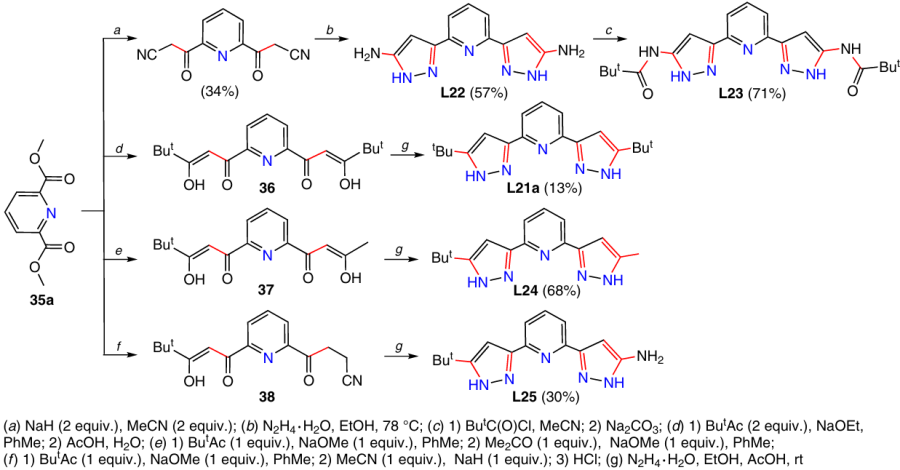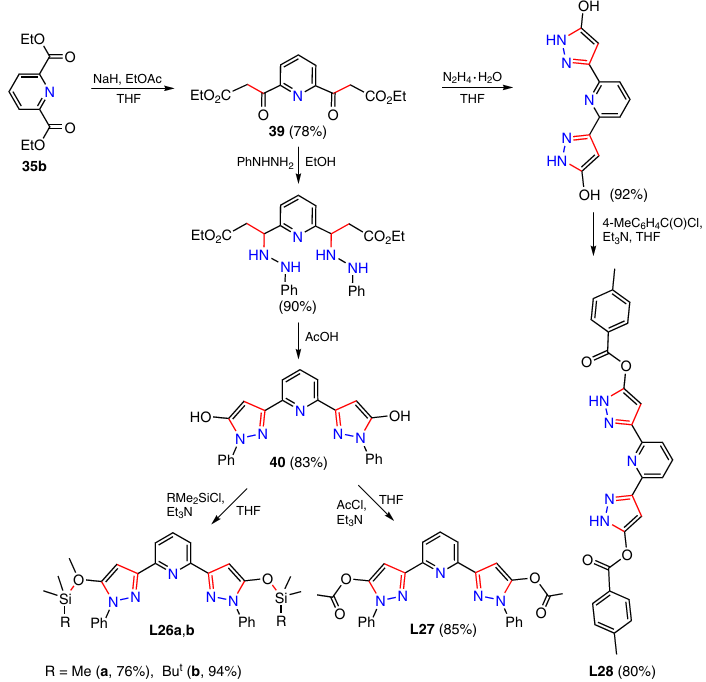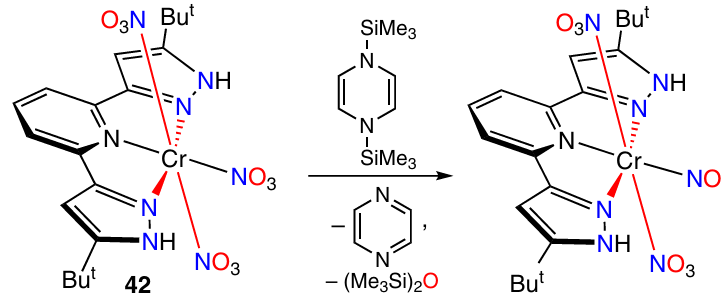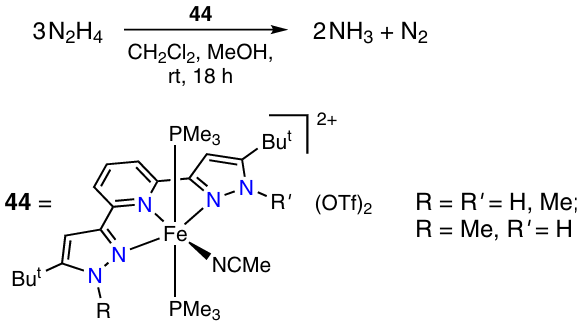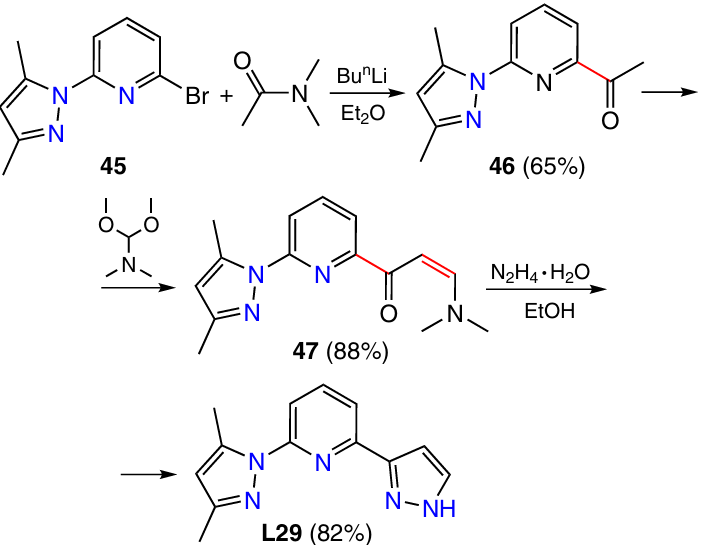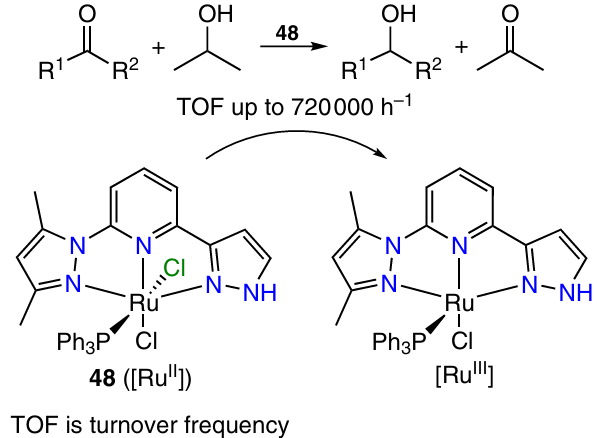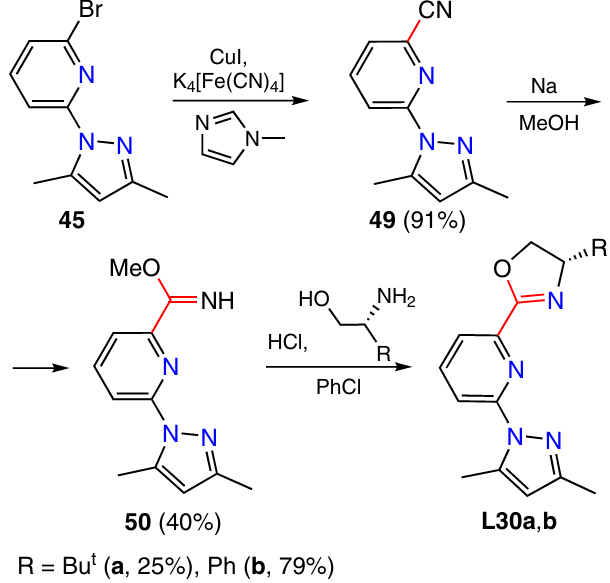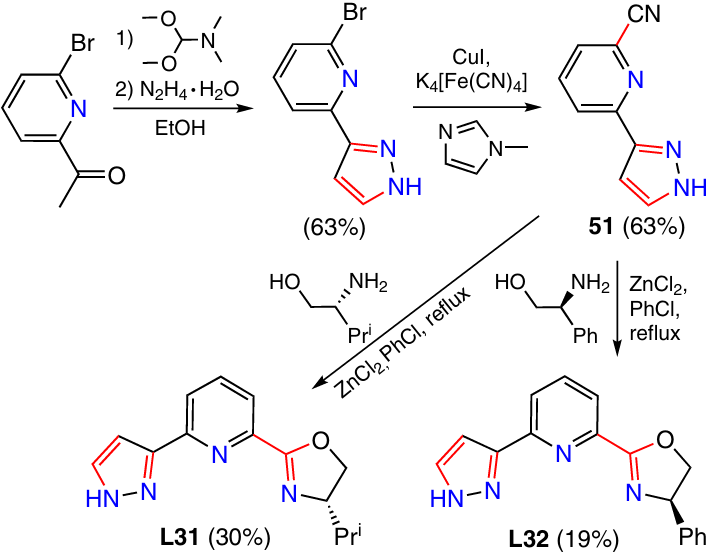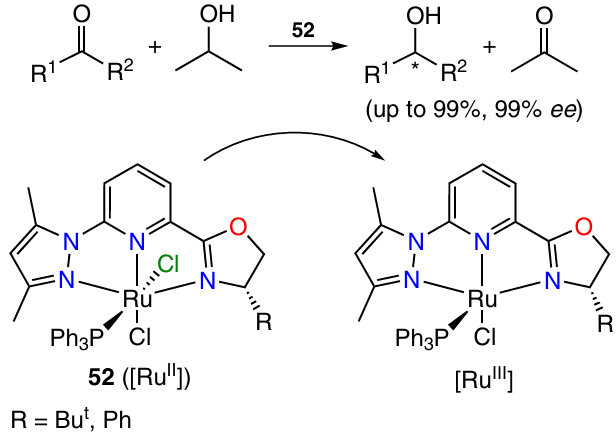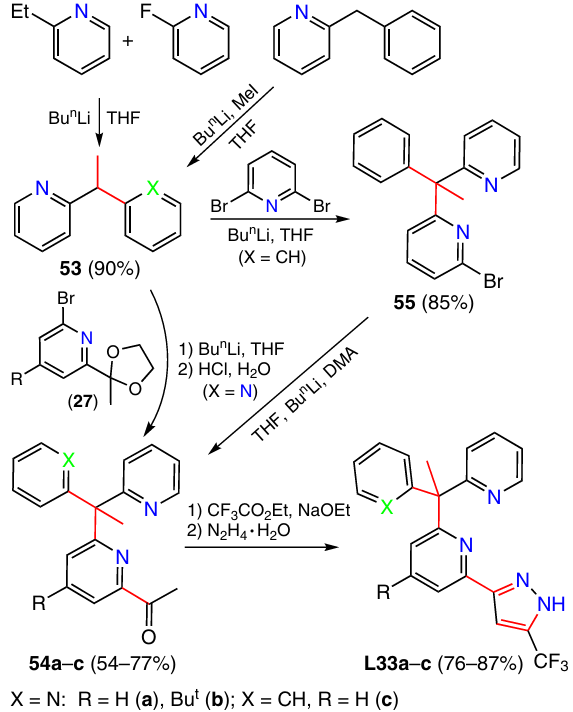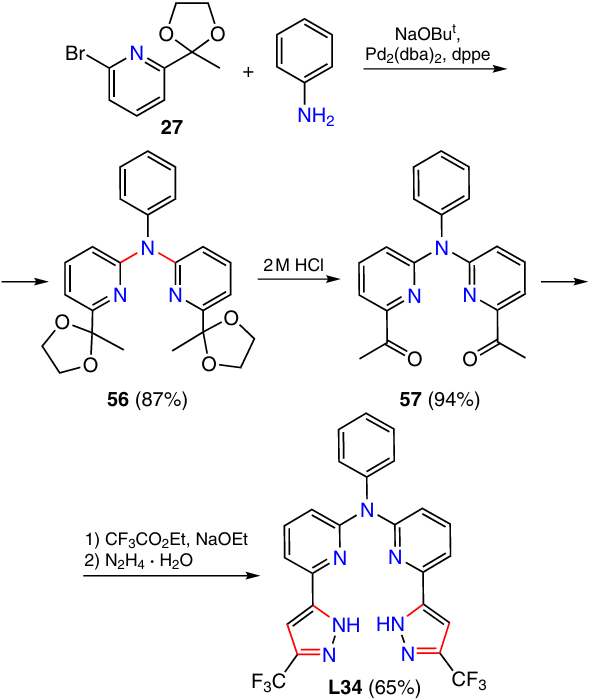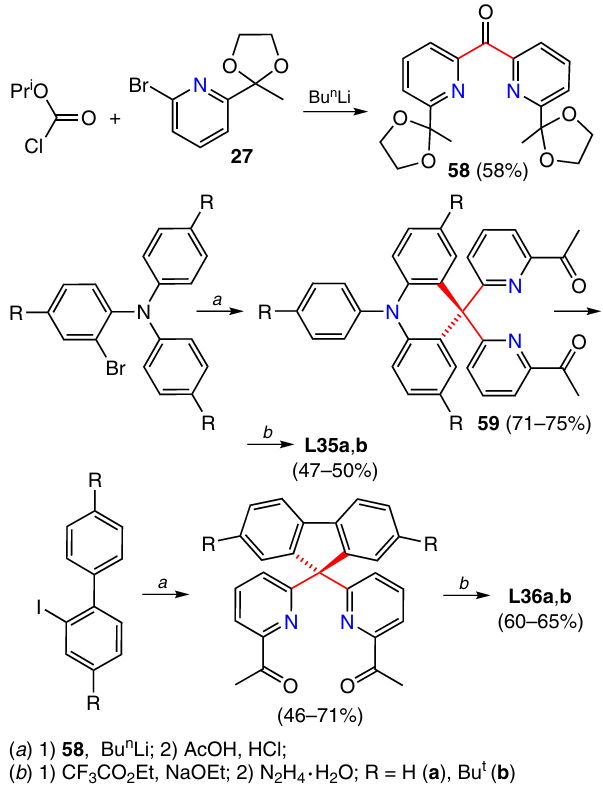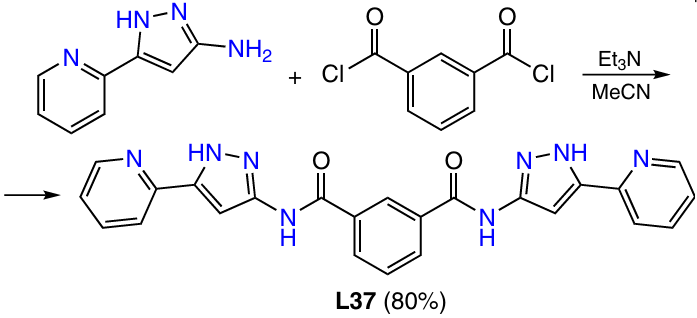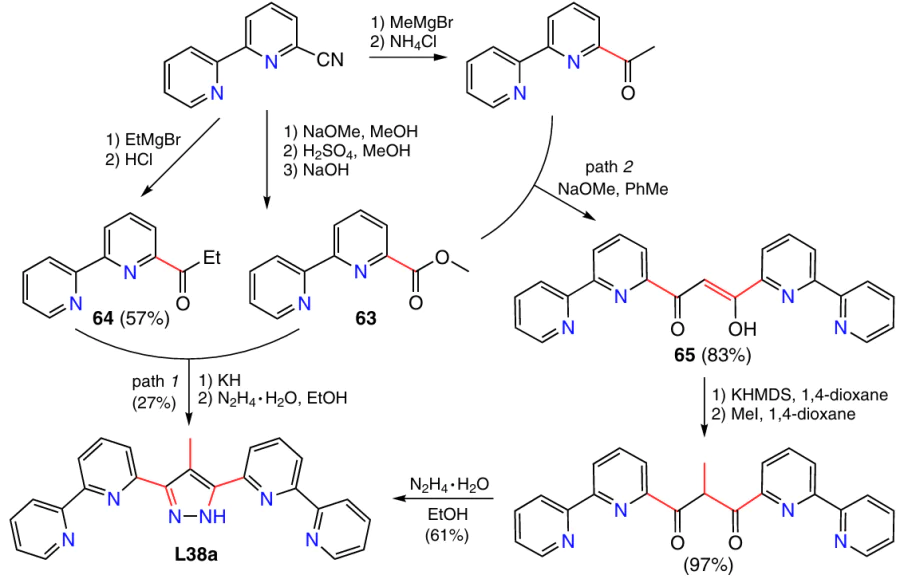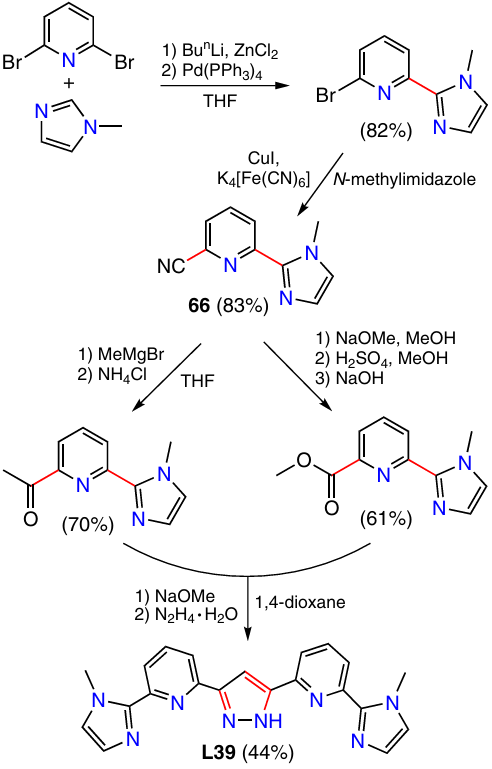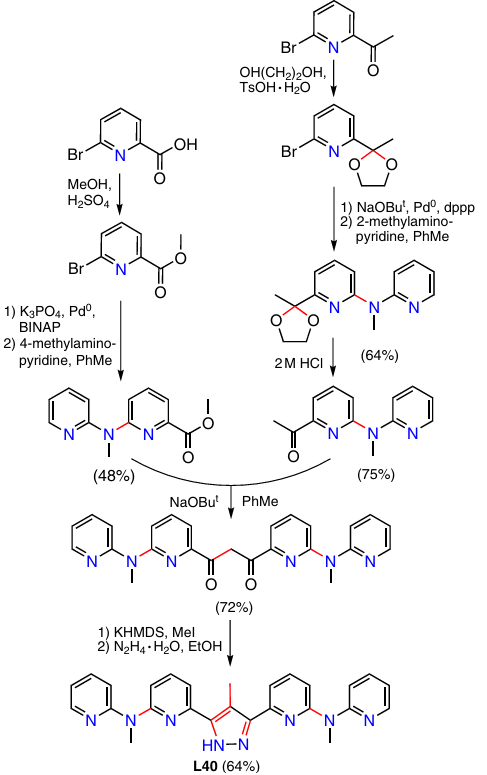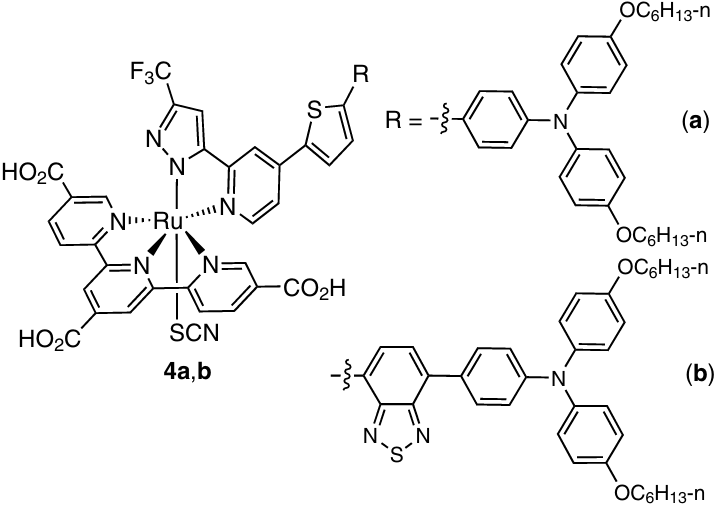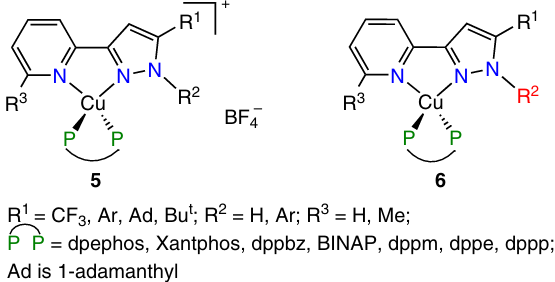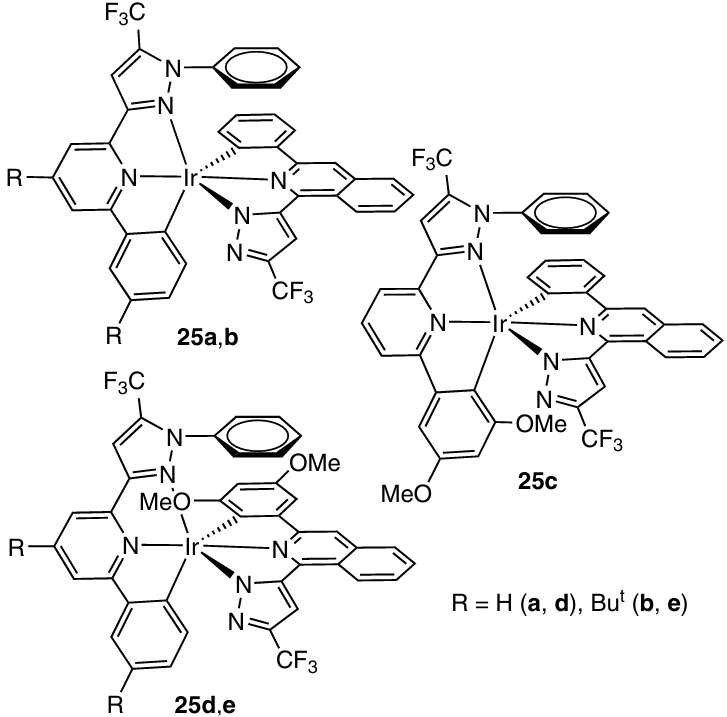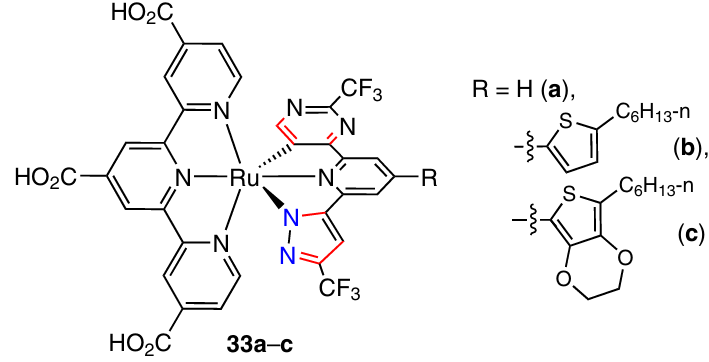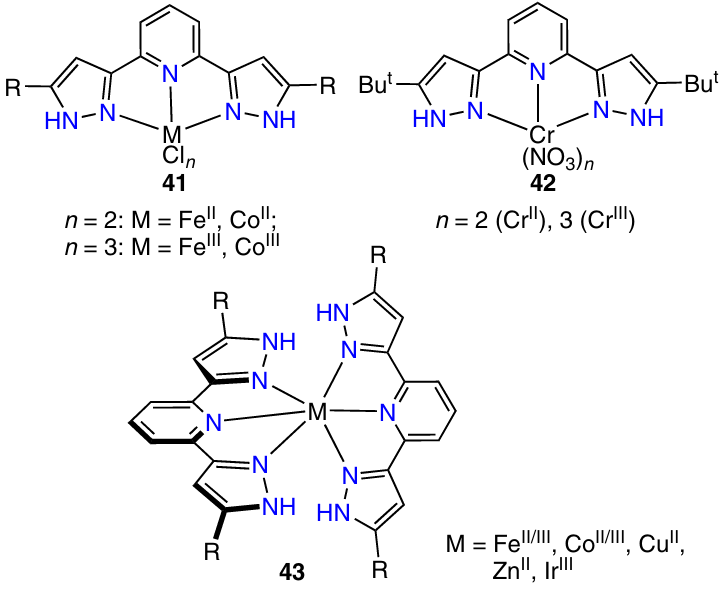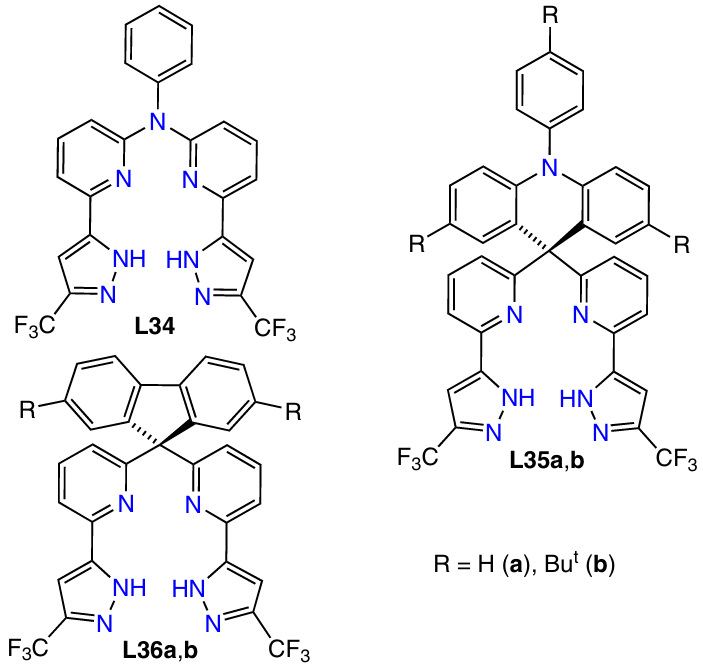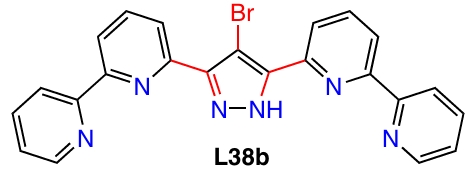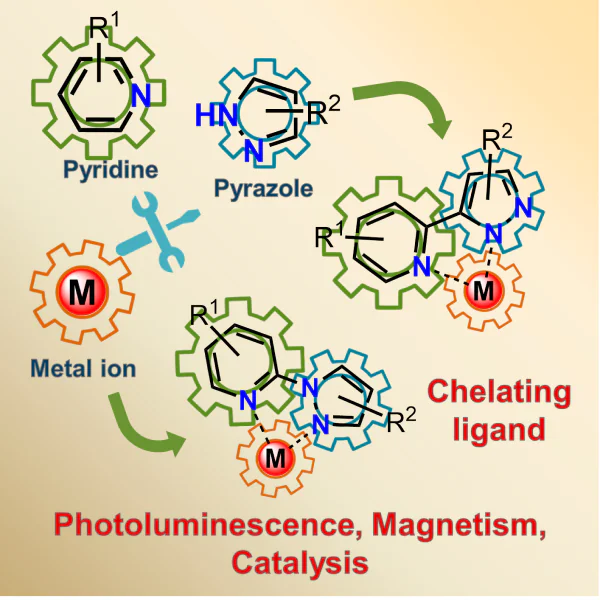Keywords
Abstract
(1H-Pyrazolyl)pyridines are highly demanded ligands in coordination chemistry. Compounds of this class are analogues of 2,2'-bipyridine ligands. They possess a number of benefits such as ready availability and the ease of synthesis. They can function as bridging counter-ions because of deprotonation of the NH group. This review summarizes the general methods for the synthesis of pyrazole derivatives substituted with pyridine in position 1 or 3(5). The approaches to the preparation of (1H-pyrazolyl)pyridine ligands, arranged according to the type of coordination, are integrated and analyzed. The coordination compounds of various metals, including noble and coin metals, formed on the basis of these ligands, are described. It was shown that the structure of pyrazolylpyridine determines the photophysical and chemical properties of the metal complex. The results can be used to establish the functional ligand — structure of the complex — property relationships.
The bibliography includes 119 references.
1. Introduction
Five-membered nitrogen-containing heterocycles are frequently used ligands in the coordination chemistry. Among azole systems, an important place belongs to pyrazoles containing nitrogen atoms in adjacent positions. The interest in pyrazoles is due to the fact that they can act as counter-ion bridging ligands in the deprotonated form. This opens up the way to convert them to neutral mono-, bi-, or polynuclear metal complexes and cyclic coordination compounds.1 – 4 By functionalization of the starting ligand, it is possible to tune the properties of the metal complex based on this ligand.5 – 7 An example of pyrazole-derived chelating ligands are pyrazolylpyridines. The structure and coordination properties of compounds of this class are similar to those of 2,2'-bipyridine ligands, but they have a number of advantages. First, owing to rather simple methods of synthesis of pyrazolylpyridines, it is possible to vary the steric and electronic factors and thus to influence the structure and properties (photophysical, magnetic, catalytic, etc.) of metal complexes. Second, the possibility of obtaining neutral complexes is useful, for example, for the production of thin films for organic light-emitting diodes (OLEDs).
The development of pyrazolylpyridine chemistry is closely related to luminescent noble metal complexes,8, 9 including those designed for the use as chemosensors.10 The greater part of publications in which these ligands are described address ruthenium,11 osmium, iridium 12 – 18 and platinum complexes.19 In recent years, there was increasing interest in pyrazolylpyridine complexes with rare earth metals and group 11 metals (copper, silver and gold).20 – 24 Analysis of the published data demonstrates that the heteroligand complexes of these metals with 2,2'-bipyridine derivatives and bis-phosphines do not show high photolumiscence efficiency (photoluminescence quantum yields are typically < 50%); therefore, they cannot be used in the design of OLED and LEEC devices (LEEC is a light-emitting electrochemical cell). Meanwhile, luminescence quantum yields for copper(I) complexes with pyrazolylpyridine ligands can be nearly quantitative. Neutral trinuclear copper(I) and silver(I) complexes exhibiting luminescent properties were obtained from unsaturated 2-(1H-pyrazol-3(5)-yl)pyridine.25 Despite the presence of quite a few publications addressing metal complexes with pyrazolylpyridine derivatives,26, 27 the role of the ligand environment, which determines the structure and properties of the coordination compound, is virtually neglected. These studies are mainly published in journals specializing in inorganic chemistry and materials science. The ligand synthesis is often described in Supplementary Materials or is presented as references to earlier publications, which considerably complicates handling of this information. The search through databases usually does not bring references to original procedures for the synthesis of pyrazolylpyridines. Until recently, methods for the synthesis of such ligands and pathways for ligand modification for the preparation of metal complexes have not been integrated or systematized. This review is devoted to pyrazole derivatives containing a pyridine ring at the carbon atom in position 3(5)* or at the pyrrole nitrogen atom. The simplest representatives of this class of compounds are 2-(1H-pyrazol-3(5)-yl)pyridine (L1) and 2-(1H-pyrazol-1-yl)pyridine (L2). The key methods for the synthesis of these compounds as platforms for the design of metal complexes and materials possessing various physical (luminescent, magnetic) and chemical (catalytic) properties are discussed and analyzed.
This review is intended to help researchers who do not specialize in organic synthesis to establish the relationship between the method of synthesis and structure of a functionalized ligand and the properties of the obtained metal complex.
* Prototropic tautomerism of NH pyrazoles containing a substituent near to a heteroatom leads to equivalence of positions 3 and 5, i.e., to the absence of isomerism; therefore, the structural formulae of such compounds presented in the review coincide with those given in original sources.
2. General synthetic routes to 1H-pyrazol-3(5)-ylpyridines
2.1. Preparation of unsubstituted 2-(1H-pyrazol-3(5)-yl)pyridine
2.1.1. Condensation of 2-acetylpyridine with N,N-dimethylformamide dimethyl acetal
The synthesis of unsubstituted 2-(1H-pyrazol-3(5)-yl)pyridine (L1) was first described in 1992 by German researchers, Brunner and Scheck,28 and consisted in condensation of 2-acetylpyridine with N,N-dimethylformamide diethyl acetal followed by cyclization in the presence of hydrazine (Scheme 1). In that study, 2,6-diacetylpyridine was also proposed as a platform for the preparation of a tridentate ligand, 2,6-bis(1H-pyrazol-3(5)-yl)pyridine (L3). Several optically active derivatives were prepared by N-alkylation of the pyrazole ring in compound L1; these products were used as enantioselective catalysts.28
Subsequently, unsubstituted 2-(1H-pyrazol-3(5)-yl)pyridine was studied in detail by Professor Thiel and co-workers, who used this compound as a ligand in metal-catalyzed reactions of olefins,29, 30 hydrosilylation,31 CO2 hydrogenation,32 and photoinduced proton transfer reactions.33
2.1.2. Catalytic [3 + 2]-cycloaddition of alkyne to (N-isocyanimino)triphenylphosphorane
Unsubstituted pyrazolylpyridine L1 has also been prepared by catalytic [3 + 2]-cycloaddition of the appropriate alkyne to N-isocyanoiminotriphenylphosphorane (Scheme 2).34
The authors proposed the following reaction mechanism (Scheme 3). The first step includes two parallel reactions: generation of molybdenum isocyanide complex (1)* by the reaction of (N-isocyanimino)triphenylphosphorane with Mo(CO)6 and σ-activation of 2-pyridylacetylene via the reaction with Ag2CO3 . The subsequent [3 + 2]-cycloaddition of intermediate 1 to silver acetylide 2 affords pyrazole zwitter-ion 3. In the final step, base-induced hydrolysis takes place to give product L1.
* Two types of numbering are used in the review: the numbers preceded by letter L refer to the main investigation objects, pyrazolylpyridine ligands, while auxiliary compounds such as reaction substrates and intermediates and metal complexes are numbered by Arabic numerals.
2.2. Synthesis of substituted pyrazol-3(5)-ylpyridines
2.2.1. Introduction of a substituent into position 4 of the pyrazole ring
Direct introduction of functional groups into unsubstituted 2-(1H-pyrazol-3(5)-yl)pyridine (L1) opens up the possibility of subsequent modification of this ligand. Thiel and co-workers 31, 32 described the preparation of 4-halo and 4-nitro derivatives L4a – c (Scheme 4).
2.2.2. Reactions of diketones with hydrazine hydrate
A key method for the preparation of substituted pyrazoles is the reaction of diketones with hydrazine hydrate. Pyrazolylpyridines substituted in position 3 of the pyrazole ring were obtained in the 1970s – 1980s by the Claisen condensation followed by cyclization induced by hydrazine.35, 36 Particularly this approach is currently used most often to prepare 2-(1H-pyrazol-3(5)-yl)pyridines L5 substituted in both the pyridine and pyrazole rings (Scheme 5).32, 37
2.2.3. Introduction of a substituent into the pyridine ring
(5(3)-Trifluoromethylpyrazol-3(5)-yl)pyridines L6а – с with substituents in position 3 or 4 of the six-membered ring are obtained from appropriate pyridine derivatives along two pathways (Scheme 6).38 One path consists in direct acylation of substituted pyridine at position 2 on treatment with acetaldehyde in the presence of a mixture of FeSO4 · 7 H2O, ButOOH and CF3COOH. The other alternative is a three-step synthesis that implies successive oxidation of substituted pyridine, cyanation of the resulting pyridine N-oxide and the methylation with the Grignard reagent (see Scheme 6).38
This synthetic sequence makes it possible to introduce bulky substituents into ligand L6 and prevents the appearance of intermolecular contacts in the complexes. Platinum(II) complexes with the deprotonated form of this ligand are efficient blue phosphorescent emitters, which were used to fabricate white light emitting diodes.38
(1H-Pyrazol-3(5)-yl)pyridine derivatives L7a,b containing a thiophene ring with bulky amino groups in the pyridine moiety were prepared from ethyl 4-chloro-α-picolinate (Scheme 7).39 In the first step, the starting reactant was subjected to the Stille cross-coupling with 2-(tri-n-butylstannyl)thiophene to give ethyl 4-(2-thienyl)picolinate, in which the thiophene ring was brominated at position 5. After conversion of the ester group to the acetyl group, the bromine atom was replaced by the CF3 group, and the free NH group of pyrazole was protected. Finally, Suzuki cross-coupling with pre-synthesized pinacol esters of arylboronic acids was carried out. It is noteworthy that the tetrahydropyran protection of the pyrazole NH group proved to tolerate the cross-coupling conditions and was easily removed on treatment with trifluoroacetic acid.
It was shown 39 that the efficiency of solar batteries based on RuII complexes 4a,b containing compound L7 as an auxiliary ligand substantially increased upon introduction of electron-donating amino groups, especially when they were linked via a benzothiazole bridge (Scheme 8). In the presence of these substituents, the extinction coefficient of the resulting dyes and their complexes increased several-fold, in particular in the visible region. The influence of the electron-donating or -withdrawing properties of the substituent on energy conversion efficiency was demonstrated.
2.2.4. Arylation of the NH group of pyrazole
The introduction of an aryl moiety into the free NH group of the pyrazole ring may considerably enhance the steric effects in the ligand. A number of N-aryl-substituted 2-(1H-pyrazol-3(5)-yl)pyridines (L8a – d) were prepared by the copper-catalyzed C – N coupling reaction (Scheme 8).40
Complexes of group 11 monovalent metals (so-called coinage metals) with pyrazolylpyridine derivatives are rather poorly addressed in the literature.40 – 46 For example, targeted modification of 2-(1H-pyrazol-3(5)-yl)pyridines to be used as ligands in copper(I) complexes has barely been reported. The initial ligands were usually prepared by a standard procedure, including the condensation of the appropriate esters and ketones (see Scheme 3). The effect of the ligand structure on the photophysical properties of the complexes was mainly determined by varying steric properties. It was shown that substituents in the pyrazolylpyridine ligands 40, 41 or in bis-phosphine 46 prevent the structural changes that may take place during electron transitions upon excitation or emission, thus decreasing the contribution of non-radiative relaxation and retaining the high efficiency of emission.
Copper(I) complexes 5 and 6 with bis-phosphine bridging or chelating ligands were prepared using compounds L8 or their NH analogues, particularly bis(2-diphenylphosphinophenyl) ether (dpephos), 9,9-dimethyl-4,5-bis(diphenylphosphino)xanthene (Xantphos), 1,2-bis(diphenylphosphino)benzene (dppbz), 2,2'-bis(diphenylphosphino)-1,1’-binaphthyl (BINAP), bis(diphenylphosphino)methane (dppm), 1,2-bis(diphenylphosphino)ethane (dppe) and 1,3-bis(diphenylphosphino)propane (dppp). The key feature of these complexes is bright luminescence with a quantum efficiency much exceeding that observed for analogous heteroligand 2,2'-bipyridine complexes;13 there these compounds are applicable for the design of OLED devices.40
2.2.5. 1,3-Dipolar cycloaddition reaction involving diazo compounds
A popular method for the synthesis of pyrazoles is 1,3-dippolar cycloaddition of diazo compounds to a triple bond.47 The reaction of tosylhydrazones with acetylenes in the presence of a base provides in situ generation of diazo derivatives, which undergo cycloaddition reactions with unsaturated compounds. A putative mechanism of this reaction was described in 2003 (Scheme 9).48 In the first step, substituted aldehyde reacts with tosylhydrazine in the presence of a strong base (alkali metal hydroxide) to give intermediate salt 7, which is converted to reactive diazo derivative 8. This is followed by 1,3-cycloaddition reaction of 8 with substituted acetylene (see path 1 in Scheme 9). Meanwhile, the addition of olefin with a good leaving group to the obtained diazo derivative 8 furnishes 3,5-substituted pyrazole after elimination of HХ (aromatization) from cycloaddition intermediate 9 (see path 2).
This approach served as the basis for developing a preparation procedure for a broad range of substituted pyrazoles;48 – 51 in some cases, gaseous acetylene was used in the synthesis.52 It is noteworthy that the above-cited studies do not describe the synthesis of 2-pyridyl derivatives. In 2015, Perez-Aguilar and Valdes 53 reported a one-step method for the preparation of substituted pyrazoles, including 2-[3(5)-methyl-4-(2-methoxyphenyl)-1H-pyrazol-5(3)-yl]pyridine (L9), by the dipolar cycloaddition of aryl-substituted acetylenes and proposed the mechanism of the reaction. Important achievements of this study are the discovery of an additional intermediate of [1,5]-sigmatropic rearrangement (10) and the possibility of synthesizing trisubstituted pyrazoles (Scheme 10).
It can be seen that the above methods provide the synthesis of a moderate variety of pyrazolylpyridines. The formation of products is mainly presented with the goal to demonstrate the synthetic potential of various approaches. The use of diketones or keto alcohols obtained by Claisen condensation as the reactants opens up synthetic routes to pyrazolylpyridines containing desired substituents or functional groups, because this condensation can proceed for various acetyl derivatives and esters. Analysis of the published data showed that 2-(1H-pyrazol-3(5)-yl)pyridine ligands meant for complex formation with metals are obtained, most often, from diketones or keto alcohols.
3. General methods for the synthesis of 1H-pyrazol-1-ylpyridines
The presence of two nitrogen atoms capable of metal coordination in one five-membered ring accounts for the popularity of 2-(1H-pyrazol-1-yl)pyridines as chelating ligands. This part of the review is devoted to the preparation of ligands of this type. The primary attention is paid to modification of 2-(1H-pyrazol-1-yl)pyridines in order to vary their coordination capacity and the properties of the transition metal complexes they form.
The simplest approach to the synthesis of 2-(1H-pyrazol-1-yl)pyridine (L2) is based on coupling of a pyridine containing a leaving group in position 2 with NH pyrazole (Scheme 11).
Several procedures for the synthesis of 2-(1H-pyrazol-1-yl)pyridines based on this approach have been reported in the literature. The main restrictions are imposed on the nature of substituents in the starting compounds, pyrazole or pyridine. For example, refluxing of 2-hydroxypyridine and substituted pyrazoles in POCl3 affords 2-(1H-pyrazol-1-yl)pyridine derivatives L10а – с (Scheme 12).54
Ligand L2 was prepared in a high yield by coupling pyrazole with pyridinecarbamate or -sulfamate. The reaction was carried out in the presence of a catalyst, nickel nanoparticles, supported on Fe3O4@SiO2 modified with ethylenediaminotetraacetic acid (EDTA) (Scheme 13).55
The most popular method for the synthesis of N-pyridine-substituted pyrazoles is copper-catalyzed reaction of 2-halopyridines with pyrazoles (Scheme 14).56 – 59 There are a few versions of conditions for this reaction, including the use of a phase transfer catalyst, tetra-n-butylammonium bromide (TBAB), in the presence of pyridine oxide 11. Ligands L10 are formed in this reaction in high yields.
2-(1H-Pyrazol-1-yl)pyridines L11 containing substituents in the pyridine ring were prepared by amination of 2-chloropyridines with pyrazole in the presence of copper carbene complex 12 as a catalyst (Scheme 15).60
Iridium,61 cadmium,62 zinc and nickel 63 complexes with N-pyridyl-substituted pyrazoles L10 and L11 were used as photoactive compounds. Mononuclear iron complexes obtained from these ligands exhibited spin crossover 64 and cytotoxic activity.65
The introduction of luminophore groups into the ligand can change the emission wavelength and efficiency for a metal complex. For example, 2-(1H-pyrazol-1-yl)-6-diphenylaminopyridine (L11a) was prepared from 2,6-dibromopyridine (Scheme 16).66 Cyclometallated PtII complex with ligand L11а showed a bright green phosphorescence in solution. The ligand was synthesized by cross-coupling of amine with bromide in the presence of Pd(dba)2 (dba is dibenzylideneacetone) and 1,1'-bis(diphenylphosphino)ferrocene (dppf) to give 2-bromo-6-diphenylaminopyridine, which was introduced into a copper-catalyzed reaction with unsubstituted pyrazole to afford the target product in a high yield.
An alternative method for the synthesis of ligand L11a was also proposed.19 In the first step, unsubstituted pyrazole was allowed to react with 2,6-dibromopyridine on treatment with KOH in diglyme. The C – N or C – C coupling of intermediate 2-bromo-6-(1H-pyrazol-1-yl)pyridine with diphenylamine or phenylboronic acid, respectively, catalyzed by palladium complexes furnished ligands L11a,b (Scheme 17).
Orrego-Hernandez et al.67, 68 synthesized 3-aryl-1-(2-pyridyl)-4-styrylpyrazoles L12, which emitted in the blue region with high quantum yields (up to 66%). The initial condensation of substituted acetophenones with 2-pyridylhydrazine afforded hydrazones 13, which were converted to 4-formylpyrazoles 14 via the Vilsmeier – Haack reaction. Compounds 14 reacted with methyltriphenylphosphonium bromide to give a new C – C bond, and intermediate 4-vinylpyrazoles 15 were converted to target 4-styrylpyrazoles L12 by the Heck reaction with bromobenzene (Scheme 18).
4. 2-Pyrazolylpyridines as tridentate CNN ligands
The cyclometallated platinum metal complexes became popular due to their phosphorescence, which determines the scope of their applicability. The photophysical properties of this class of luminophores can be tuned by optimization of the donor – acceptor properties of ligands with a metal – carbon covalent bond and auxiliary ligands, which is attained by variation of substituents. The interest in the use of 2-pyrazolylpyridine derivatives as cyclometallating ligands has markedly increased in recent years owing to the broad range of their synthetic modification.
4.1. Introduction of aryl substituent into position 6 of the pyridine ring
In order to obtain chelating ligands from 2-pyrazolylpyridines, it is necessary to introduce an alkyl or aryl substituent into position 6 of the pyridine moiety. 2,6-Dibromopyridine is utilized most often as the starting compound for the synthesis of these derivarives.69 – 73 This compound is lithiated, and the product reacts with N,N-dimethylacetamide to yield 2-acetyl-6-bromopyridine. This is followed by Suzuki cross-coupling with the corresponding arylboronic acid and the condensation of intermediates 16 with ethyl trifluoroacetate (to introduce a trifluoromethyl group) or with dimethylformamide dimethyl acetal (to obtain 3-unsubstituted pyrazole). The sequence of reactions is completed by formation of the heterocycle via the reaction of the obtained carbonyl compound with hydrazine. This flexible synthetic route open up broad opportunities for tuning of luminescent properties of the resulting ligand L13 (Scheme 19).69 – 73
In these reactions, it is possible to use pinacol esters of arylboronic acids.17 On the basis of 6-aryl-2-pyrazolylpyridines L13, cyclometallated platinum(II) complexes 17 were obtained for the first time; a free NH group was retained in the ligand (Scheme 20). In the presence of a base (Et3N), proton elimination followed by halide ion elimination took place to give dimeric complexes 18.69, 74
The simplest representative of 6-phenyl-substituted 2-pyrazolylpyridines L13a was used to prepare osmium(IV) CNN pincer complex 19 (Scheme 21),75 while its homologue L13с was converted to analogous palladium(II) complex 20 (Scheme 22).76 These complexes exhibit phosphorescence in solution and in the solid state.75, 76
4.2. Introduction of a substituent to the pyrrole nitrogen atom
The introduction of a phenyl group to the pyrazole NH group during cyclization of hydrazones 21 has been reported.77 These hydrazones were prepared from substituted 2-acetylpyridine 22, which was first converted to CF3-containing diketone, and the product was allowed to react with phenylhydrazine. The cyclization of hydrazones 21 catalyzed by an ethanol solution of HCl resulted in the formation of 2-(1-phenylpyrazol-3-yl)pyridine ligands L14а – с (Scheme 23).
Gnanasekaran et al.77 described an approach to the synthesis of 3-aryl-1-[3-(trifluoromethyl)-1H-pyrazol-5-yl]isoquinolines, fused analogues of pyrazolylpyridine. The synthetic sequence started with the reaction of 2-(phenylethynyl)benzaldehyde with tert-butylamine to give imine 23, which was cyclized by treatment with CuI to afford 3-phenylisoquinoline. This product reacted with acetaldehyde to give acetylisoquinoline 24, which was converted to pyrazole L15a via the condensation with ethyl trifluoroacetate and treatment with hydrazine hydrate (Scheme 24). Product 15b was synthesized in a similar way.
Ligands L14 and L15 were used to prepare iridium(III) complexes. The presence of an aromatic substituent at the pyrazole nitrogen atom additionally stabilizes the structure of bis(tridentate) complexes 25a – e by forming intramolecular π – π contacts between the phenyl and quinoline moieties; consequently, the luminescence quantum yields may be nearly quantitative (Fig. 1).77
Steric crowding of the ligands also gives rise to a stable geometry of the complex, which prevents the vibrational relaxation of its excited state.
4.3. Introduction of substituents into positions 4 and 6 of the pyridine ring
The pyridine moiety of the pyrazolylpyridine ligands directly participates in electron transitions. By varying the electronic properties of substituents in the pyridine ring, one can shift the emission maximum to the blue (electron-donating substituents) or red (electron-withdrawing substituents) spectral ranges. For this reason, to achieve the desired properties of the complex, it is important to modify particularly the pyridine ring. Zhu et al.78 used 2,6-dibromopyridine to introduce a substituent at position 4. They developed procedures for the synthesis of 4-tert-butyl- (26а), 4-methoxy- (26b) and 4-pyrrolidino-6-acyl-2-bromopyridines (26с) (Scheme 25), which were further converted to pyrazolylpyridine ligands.
For the attachment of a tert-butyl substituent, 2,6-dibromopyridine was successively acylated and treated with pivalic acid in the presence of silver nitrate. The 4-methoxy- and 4-pyrrolidino-substituted derivatives were prepared by oxidation of the starting substrate to pyrrolidine N-oxide followed by nitration at position 4 of the pyridine ring and replacement of the nitro group by the desired moiety.
Compounds 26а – с were converted to pyrazolylpyridine ligands L16а – с containing fluorene in position 6 of the pyridine ring.78 For this purpose, first, the carbonyl group in the substrate was protected by treatment with a stoichiometric amount of ethylene glycol in the presence of p-toluenesulfonic acid (Scheme 26). The resulting 1,3-dioxolane derivatives 27 were allowed to react with equimolar amounts of n-butyllithium and fluorene to give 2-(9H-fluoren-9-yl)-6-(2-methyl-1,3-dioxolan-2-yl)pyridines (28), which were then methylated at position 9 of the fluorene substituent. The dioxolane protecting group in intermediate 2-(2-methyl-1,3-dioxolan-2-yl)-6-(9-methyl-9H-fluoren-9-yl)pyridines 29 was eliminated by the action of 2 M hydrochloric acid. The subsequent Claisen condensation of keto derivatives 30 followed by cyclization with hydrazine furnished target L16.
2-(1H-Pyrazolyl)pyridine ligands L17a,b containing a 3,5-bis(trifluoromethyl)-substituted carbazole ring in position 6 and a tert-butyl or dimethylamino group in position 4 of pyridine were obtained via a three-step synthesis (Scheme 27).79, 80 First, 4-substituted 6-acetyl-2-bromopyridines were coupled with 3,6-bis(trifluoromethyl)-9H-carbazole in the presence of CuI and a base, 1,2-diaminocyclohexane (DACH), to give trisubstituted pyridines 31. The subsequent Claisen condensation involving ethyl trifluoroacetate and hydrazine hydrate-induced heterocyclization afforded ligands L17.
The above fluorene- and carbazole-containing (1H-pyrazole-5-yl)pyridines L16, L17 were used as auxiliary ligands to obtain iridium(III) bis(tridentate) complexes exhibiting bright blue phosphorescence. Zhu and co-workers 78 – 80 showed that substituents in the pyridine ring influence the energy difference between the highest occupied (HOMO) and lowest unoccupied molecular orbitals (LUMO), which opens the way for controlling the emission characteristics for this type of complexes (Fig. 2).
Tridentate 1H-pyrazolylpyridine ligands containing a pyrimidine moiety, {4-[6-(3-trifluoromethylpyrazol-5-yl)pyridin-2-yl]-2-trifluoromethylpyrimidines L18а – с, were prepared from 2,6-diacetylpyridine and its 4-substituted analogues (Scheme 28).81 First, the carbonyl group in one acetyl substituent was protected by ethylene glycol. The other acetyl group reacted in the condensation with N,N-dimethylformamide dimethyl acetal. The subsequent heterocyclization of intermediate 32 induced by 2,2,2-trifluoroacetamidine in the presence of a base gave a CF3-substituted pyrimidine moiety in position 6. Then the acetyl group was removed by acid treatment, and the pyrazole ring was formed according to above-described procedures (see Scheme 28).
It is noteworthy that the formation of RuII complexes 33а – с with [2,2':6',2''-terpyridine]-4,4',4''- tricarboxylic acid and ligands L18 did not involve the coordination of the pyrimidine nitrogen atom to the metal. Like in the case of phenyl-substituted pyrazolylpyridines, cyclometallated derivatives were formed.
Complexes 33 were shown to be applicable as sensitizers in solar batteries.81
5. Tridentate ligands based on pyrazolylpyridines
5.1. Phosphorus- and sulfur-containing tridentate ligands
Professor Caulton and co-workers 82 proposed a modification pathway for the 2-(1H-pyrazol-3(5)-yl)-6-methylpyridine molecules to introduce phosphorus and sulfur atoms into the α-methyl substituent and obtain NNP and NNS pincer ligands. Ligands L19a,b, containing phenyl or tert-butyl group in the pyrazole moiety and di-tert-butylphosphine group in the pyridine ring, were prepared by a three-step synthetic route. First the Claisen condensation of methyl 6-methylpicolinate with pinacolone (3,3-dimethylbutan-2-one) or acetophenone followed by treatment with hydrazine was carried out, and then deprotonated intermediates 34 were treated with But2PCl with subsequent hydrolysis (Scheme 29). The addition of elemental sulfur to L19b afforded phosphine sulfide L30, which is an SNN ligand (see Scheme 29).
Pyrazolylpyridine ligands L19 and L20 were used to prepare cobalt,82, 83 iron,84 nickel,85 rhodium and zinc 86 pincer complexes, which have redox activity and catalytic properties.
5.2. NNN ligands with two pyrazole moieties
2,6-Bis(pyrazolyl-3(5)-yl)pyridine derivatives are in fairly wide demand in coordination chemistry. A significant part of studies of these ligands are devoted to the preparation of transition metal complexes that exhibit magnetic properties.87, 88 Ligands of this type (e.g., compounds L21a – c) are synthesized from dimethyl pyridine-2,6-dicarboxylate (35а).89 The reaction of 35a with pinacolone in the presence of sodium hydride afforded 1,3-bis(diketone) 36, which was then cyclized by treatment with hydrazine hydrate (Scheme 30).89 The acid protons of pyrazole were replaced by the methyl group by slow addition of two equivalents of trimethyloxonium salt in the presence of NaH.90 When an equimolar amount of methyl iodide is added, the NH group of only one five-membered ring is substituted, while the addition of a second equivalent results in the methylation of nitrogen atoms of both pyrazole rins.91
Dimethyl pyridine-2,6-dicarboxylate was also used to synthesize 2,6-bis(pyrazolyl-3(5)-yl)pyridines L22 – L25 with other substituents in the pyrazole ring, including unsymmetrical derivatives (Scheme 31).92 – 94 To introduce an amino group to substrate 35a, sodium hydride in acetonitrile was added, and then cyclization with hydrazine hydrate was carried out. Treatment of the resulting diamino-bis(pyrazolyl)pyridine L22 with pivaloyl chloride in acetonitrile gave intermediate hydrochloride, which was converted to free base L23 upon the addition of Na2CO3 . The reaction of diamino-substituted ligand L22 with acyl or benzoyl chloride gave di(methylamino) or di(phenylamido) derivatives. The variation of conditions for the reaction of dimethylpyridine-2,6-dicarboxylate (35a) with pinacolone gave bis(β-diketone) 36 (shown in Scheme 31 in the enol form) and unsymmetrical β-diketones 37 and 38, which reacted with hydrazine hydrate to give ligands L21a, L24 and L25 (see Scheme 31).
The synthesis of 2,6-bis(1-phenyl-5-hydroxypyrazol-3-yl)pyridines and their silylated derivatives has been reported.95 Sterically crowded silylated ligands were used to obtain paramagnetic iron complexes. Ligands L26 – L28 were synthesized by a conventional procedure, which included the initial formation of bis(1,3-ketoester) 35b via the Claisen condensation and the subsequent cyclization of intermediate 39 with phenylhydrazine in an acid medium (Scheme 32). The silylation of 2,6-bis(5-hydroxy-1-phenylpyrazol-3-yl)pyridine 40 with Me3SiCl or Me2ButSiCl was carried out in THF using triethylamine as a base. In addition, the OH groups of the pyrazole ring can be acylated with carboxylic acid chlorides. Using acetyl chloride and p-toluic acid chloride, ligands L27 and L28, respectively, were prepared. This type of modification of substituent in the pyrazole ring makes it possible to vary the donor – acceptor properties of the ligand and to markedly increase the steric crowding.96, 97
A wide range of transition metal complexes were prepared from ligands L21 – L28, including complexes of iron,90, 91, 93, 94, 97 – 99 cobalt,93, 100, 101 chromium,102 copper, zinc 103 and iridium,104 for example, 41 – 43.
The interest in these complexes is mainly associated with their magnetic behaviour. In addition, in relation to chromium(III) complex 42, the possibility of catalytic deoxygenation of the nitrate ion to nitrosyl was demonstrated (Scheme 33).79
Iron(II) pincer complexes 44 with ligands L21а – с are active catalysts of N-N bond cleavage in hydrazines (Scheme 34).91
5.3. NNN ligands based on 2-(1H-pyrazol-1-yl)pyridine
The synthesis of tridentate ligand L29, which contains 1- and 3(5)-substituted pyrazole in the pyridine ring, was reported by Jin et al.105 The authors used 2-bromo-6-(3,5-dimethylpyrazol-1-yl)pyridine (45) as the starting compound; the sequence of transformations included three steps (Scheme 35). In the first step, substrate 45 reacted with N,N-dimethylacetamide in the presence of a base at −78 °C to yield 2-acetyl-6-(3,5-dimethylpyrazol-1-yl)pyridine (46). This product was treated with N,N-dimethylformamide dimethyl acetal on heating; this resulted in the formation of β-amino-substituted enone 47, which reacted with hydrazine hydrate to give the target ligand.
Ruthenium(II) complex 48 with ligand L29 is an efficient catalyst for the hydrogenation of ketones the mechanism of which includes a hydrogen atom transfer (Scheme 36).105
5.4. Unsymmetrical NNN ligands with oxazoline ring
Ye et al.106 reported 2-(1H-pyrazolyl)pyridines L30 – L32 containing chiral oxazoline moieties in position 6. Ligands L30a,b were synthesized by a three-step sequence of reactions. In the first step, 2-bromo-6-(pyrazol-1-yl)pyridine 45 was subjected to the copper complex-catalyzed reaction with potassium ferrocyanide, which resulted in the formation of a new C – C bond. The subsequent reaction of cyanide 49 with methanol in the presence of sodium gave imidate 50, which reacted with chiral amino alcohols to give target ligands (Scheme 37).
Compounds L31 and L32 were prepared from cyanide 51 via a similar route (Scheme 38).
Ruthenium(II) complexes 52 based on ligands L30a,b are involved in the catalytic hydrogen atom transfer in the asymmetric hydrogenation of ketones (Scheme 39).106
6. Polydentate ligands containing different types of coordination sites
6.1. Tetradentate CNNN and NNNN ligands
An increase in the number of coordination sites in the ligand additionally stabilizes the metal complex structure. Lee and co-workers 107, 108 synthesized non-planar tetradentate pyrazolylpyridines L33а – c containing an additional nitrogen atom by introducing a sterically crowded 1,1-bis(2-pyridyl)ethyl moiety at position 6 of the pyridine ring (Scheme 40). The starting 1,1-bis(2-pyridyl)ethane (53) was prepared by coupling of 2-ethyl- and 2-fluoropyridines. One bromine atom in 2,6-dibromopyridine was substituted by a 1,1-bis(2-pyridyl)ethane moiety, while the other one was replaced by an acetyl group; this gave ketone 54a (R = H). Similar ketone 54b with a tert-butyl substituent was synthesized by the reaction of 1,1-bis(2-pyridyl)ethane (53) with 1,3-dioxolane, with the dioxolane protecting group being subsequently removed. Intermediates 54 were treated successively with ethyl trifluoroacetate in the presence of a base and then with hydrazine hydrate.78 Tetradentate pyrazolylpyridine L33с containing a phenyl group instead of one of the pyridine rings was synthesized from commercially available 2-benzylpyridine by a similar route.79 In this case, intermediate 55 was isolated in a pure state in a high yield.
Depending on the reaction conditions and the starting reactants, compounds L33 can be complexed with iridium(III) as either tridentate (see the structure of [Ir(κ3-L33с)Cl2]2 in Fig. 3) or tetradentate ligands (see, for example, [Ir(κ4-L33a)Cl2] and [Ir(κ4-L33a)Cl · Py)]). The complexes show blue to green emission, depending on substituents and structure, with a good electroluminescence quantum efficiency.107, 108
6.2. Ligands containing two pyrazolylpyridine moieties
Tetradentate ligands able to form complexes with either square planar or distorted tetrahedral metal ion environment are of considerable interest. A change in the ligand structure may markedly stabilize the metal oxidation state upon complexation. Conformationally flexible ligands consisting of two 2-(1H-pyrazol-3(5)-yl)pyridine moieties linked to each other by an amine nitrogen atom (L34) or spiroacridine (L35) or spirofluorene (L36) carbon atom were prepared.
Compound L34 was obtained in three steps from aniline and protected 6-acetyl-2-bromopyridine 27 (R = H).109 The first step was palladium-catalyzed coupling of reactants to give two C – N bonds. Chang et al.109 referred to the original 110 method for the synthesis of intermediate 56 and indicated the need to carry out successive reactions with one equivalent of bromo derivative 27 and isolation of intermediate compounds after each step. Then the 1,3-dioxolane moiety was hydrolyzed to the acetyl group, and the resulting diketone 57 was converted to target N,N-bis[2-(pyrazolyl)pyridyl)]aniline via the Claisen condensation and the subsequent cyclization with hydrazine (Scheme 41).
Ligands L35a,b were prepared also using 6-bromo-2-(2-methyl-1,3-dioxolan-2-yl)pyridine 27 as the starting compound. First, it was converted to ketone 58, which was allowed to react with 2-iodobiphenyl to afford tertiary alcohol 59. The subsequent dehydration and acyl deprotection in an acid medium resulted in the simultaneous formation of the spirofluorene bridge and two acetyl groups. Spiroacridine chelating ligands L36a,b were synthesized according to the same route (Scheme 42).111
Ligands L34 – L36 were utilized for the synthesis of phosphorescent osmium(II) and platinum(II) complexes 60a,b – 62a,b (Fig. 4), which served for the fabrication of red,109 blue and white 111 OLED devices.
Bis-amide ligand N1,N3-bis[5(3)-(2-pyridyl)-1H-pyrazol-3(5)-yl]isophthalamide (L37), containing two pyrazolylpyridine moieties, was employed to prepare nano-sized metallogels based on copper salts. This compound is formed in the reaction of 3(5)-amino-5(3)-(2-pyridyl)-1H-pyrazole 112 and isophthaloyl chloride in the presence of triethylamine in acetonitrile (Scheme 43).113
6.3. Ligands with two pyridine and one pyrazole rings
Schneider et al.114 described the synthesis of 3,5-bis(2,2'-bipyridin-6-yl)-4-methyl-1H-pyrazole (L38а), a ligand present in a cyclic tetranuclear FeII complex, which was found to be applicable as a molecular component for quantum logic devices. This ligand can be prepared from 6-cyano-2,2'-bipyridine in two ways (Scheme 44). The standard treatment of this reactant with sodium methoxide led to ester 63, while addition of the Grignard reagent followed by hydrolysis gave ketone 64. The Claisen pseudo-condensation involving intermediates 63 and 64 and the subsequent treatment with hydrazine furnished the target product in a moderate yield. Alternatively, ester 63 reacts with 6-acetyl-2,2'-bipyridine to give 1,3-diketone 65, which is methylated in the presence of a strong base, potassium bis(trimethylsilyl)amide (KHMDS). The final cyclization with hydrazine results in the formation of ligand L38а.
Analogous ligand L38b with a bromine atom in position 4 of the pyrazole moiety is formed upon the bromination of 3,5-bis(2,2'-bipyridin-6-yl)-1H-pyrazole.115
3,5-Bis[6-(1-methyl-1H-imidazol-2-yl)pyridin-2-yl]pyrazole (L39) was prepared from 2,6-dibromopyridine and 1-methyl-1H-imidazole. This ligand has a central pyrazole ring, positions 3 and 5 of which are substituted with pyridine moieties, which are both substituted with 1-methyl-1H-imidazole moieties (Scheme 45). The key intermediate compound, 6-cyano-2-(1-methyl-1H-imidazol-2-yl)pyridine (66), was modified by two routes involving the intermediate formation of 6-acetyl- and 6-methoxycarbonyl-2-(1-methyl-1H-imidazol-2-yl)pyridines, respectively. The Claisen condensation of these intermediates followed by hydrazine-induced condensation furnished ligand L39 (see Scheme 45).116
As a continuation of studies of the magnetic properties of iron complexes, Professor Meyer and co-workers 117 synthesized a polydentate ligand containing four pyridine rings and one pyrazole ring: 3,5-bis{2-[N-methyl-N-(2-pyridyl)]aminopyridin-6-yl}-4-methyl-1H-pyrazole (L40). Bromosubstituted α-picolinic acid and α-acetylpyridine were used as the starting compounds; the sequence of transformations is shown in Scheme 46.
Ligands L38 – L40 were converted to a broad range of iron complexes exhibiting spin crossover.114, 115, 117, 118 Binuclear ruthenium complex with ligand L38a proved to be an efficient water oxidation catalyst.119
Thus, the introduction of additional coordination sites into ligands based on pyrazolylpyridines gives rise to metal complexes with a desired environment and required geometrical parameters and makes it possible to directly influence their properties.
7. Conclusion
This review systematizes published data on the methods of synthesis and functionalization of 1H-pyrazolylpyridines and gives the structures and properties of coordination compounds of various metals with these ligands. One of the goals of this publication is to demonstrate the possibilities of the title ligands to directly affect the properties of metal complexes. The presented data are meant to contribute to establishing the ‘functional ligand – metal complex structure – property of the complex’ relationships. The currently available studies on 1H-pyrazolylpyridine ligands mainly address the luminescent properties of the complexes. Among them, the greater part of papers are devoted to phosphorescent noble metal complexes, which are applicable for the design of OLED devices and solar cells. Data on group 11 metal complexes with 1H-pyrazolylpyridine ligands are limited to three dozens of examples. The possibility of preparing these ligands in the deprotonated form makes it possible to obtain neutral complexes, which simplifies the fabrication of thin films for OLED devices. Meanwhile, metal complexes with pyridine-pyrazole derivatives in the NH form are efficiently used in catalytic reactions owing to their ability to proton transfer or to additional stabilization of intermediates upon coordination. For this reason, the preparation of new ligands containing various functional groups and coordination compounds based on them remains relevant.
One more goal of this work is to demonstrate the advantages of 1H-pyrazolylpyridine ligands over 2,2'-bipyridine derivatives. The data presented in the review demonstrate the ease of preparation of 1H-pyrazolylpyridines and the ways to modify them according to the selected goal. The presence of two linked rings, pyridine and pyrazole ones, accounts for the wide choice of synthetic pathways. The key method of combining these heterocyclic moieties is the condensation of an ester and a ketone. Modification of both reactants before this step allows relatively easy synthesis of the target products with desired properties. This review should help scientists specializing in various fields of chemistry, including those unrelated to organic synthesis, to obtain a sufficient amount of information about 1H-pyrazolylpyridines as multifunctional building blocks for metal complexes.
This review was written with the financial support of the Russian Science Foundation (Project No. 22-73-10130). Access to electronic resources and databases was provided by the A. N. Nesmeyanov Institute of Organoelement Compounds, Russian Academy of Sciences, with the support of the Ministry of Science and Higher Education of the Russian Federation.
8. List of abbreviations and symbols
The following abbreviations and symbols were used in the review.
BINAP — 2,2'-bis(diphenylphosphino)-1,1’-binaphthyl,
B2Pin2 — bis(pinacolato)diboron,
DACH — diaminocyclohexane,
dba — dibenzylideneacetone,
DMA — N,N-dimethylacetamide,
dpephos — bis(2-diphenylphosphinophenyl) ether,
dppbz — 1,2-bis(diphenylphosphino)benzene,
dppe — 1,2-bis(diphenylphosphino)ethane,
dppf — 1,1'-bis(diphenylphosphino)ferrocene,
dppm — bis(diphenylphosphino)methane,
dppp — 1,3-bis(diphenylphosphino)propane,
EDTA — ethylenediaminetetraacetic acid,
HOMO — highest occupied molecular orbital,
LEEC — light-emitting electrochemical cell,
LG — leaving group,
OLED — organic light-emitting diode,
KHMDS — potassium bis(trimethylsilyl)amide,
LUMO — lowest unoccupied molecular orbital,
MW — microwave radiation,
NBS — N-bromosuccinimide,
NP — nanoparticles,
PMP — p-methoxyphenyl,
PTC — phase transfer catalyst,
Py — 2-pyridyl,
rt — room temperature,
Ts — p-toluenesulfonyl (tosyl),
TBAB — tetra-n-butylammonium bromide,
Xantphos — 9,9-dimethyl-4,5-bis(diphenylphosphino)xanthene.




![Molecular structure of the Ir[(L14а)(L15a)] complex (25а) according to X-ray diffraction data (the red dashed line marks the intramolecular π–π contacts) (a) and electroluminescence curves of complexes 25а (1) and 25e (2).77](/storage/images/resized/TaNijrsnRS3UMlCZf6pmEhJiy8FMtuPZcuurX5IK_xl.webp)
